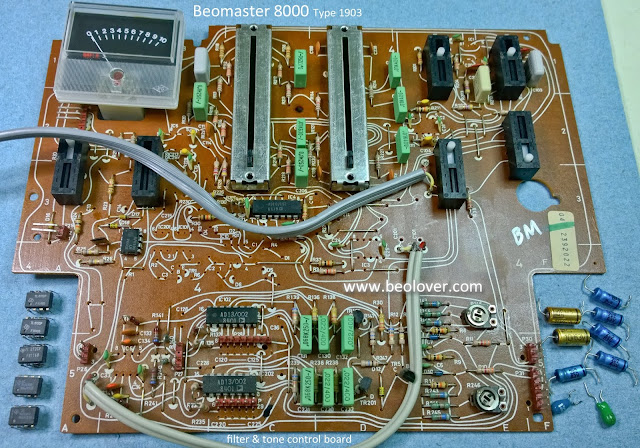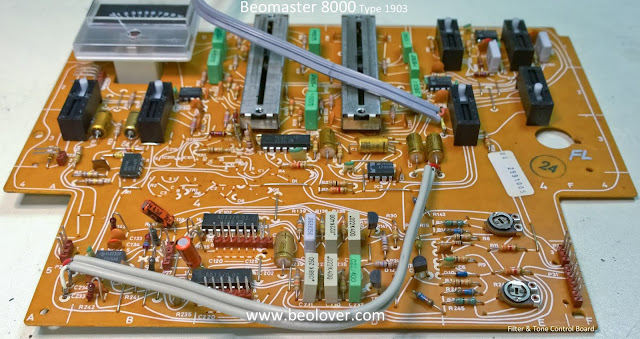Today I got the Texas Beomaster 8000 project caught up to where the Canada Beomaster 8000 project is. Both receivers now have reworked output amplifier board assemblies, reservoir capacitors, speaker switches and power supply boards. Both units also needed cabinet and frame treatments to get back to like new condition. All of those tasks are now reassembled into each Beomaster.
Here is the current state of the Beomaster 8000 from Texas.
The road to this point in the restoration was similar to that of the Beomaster 8000 from Canada. The bottom plates of the cabinet didn't have any rust but they were quite dirty and had places where bare metal was exposed. So like the previous Beomaster 8000
I took everything apart, cleaned and repainted the base plates.
Here are the base plates repainted.
Next I replaced the reservoir capacitors, changing out the original ones for Beolover replacement reservoir capacitors.
Here is the Beomaster 8000 frame with the reservoir capacitors removed.
Here are the new, Beolover replacement parts next to the original capacitors. You can see that the Beolover 3D printed housing retains the original size which is important in accurately rebuilding the Beomaster 8000.
Here are the new left and right channel reservoir capacitors. I am leaving the wires for the left channel reservoir capacitors disconnected for now so the wires have enough play in them for the left channel output amplifier assembly installation.
While the Beomaster frame still has the base plates removed I will update the two speaker switches. It is easier to work on those with most of the components out of the way.
Here are the two original speaker switches.
Here are the two new speaker switches with the Beolover 3D printed base (so they will fit properly).
Now I can turn the Beomaster frame upside down to reinstall the cleaned and repainted base plates.
It looks quite nice if I do say so myself. There is an extra good feeling you get when everything is new and clean. The Beomaster begins to feel like it is going through the factory as a new creation...even though it is almost forty years old.
Now for the reinstallation of the output amplifier board assemblies. As usual I start with the more difficult left channel.
Turning the Beomaster cabinet back over...
You may have noticed that this time I rotated the output amplifier board 90° the opposite way than I did on the previous Beomaster 8000 left channel output amplifier installation. I am still deciding which way I like best. This time seemed like it was easier but it could just be that I am getting the hang of it. In any case this beats my original method of attaching the heatsink mounted components after installing the amplifier board.
The left channel output amplifier assembly is mounted in place so I can complete the left channel reservoir capacitor wiring now.
Next up is the right channel output amplifier installation. The 90° board rotation technique would work here but I have been able to reinstall the board without turning it.
The final step of this install is to secure the back panel to the heat sinks.
The last task in the restoration catch up is to clean and recap the power supply board. That includes the small heat sink with the voltage regulators.
This power supply board was pretty dirty. It has also been worked on before. The C51 1uF capacitor had been replaced by a 2.2uF capacitor for some reason. I will put everything back to the values that are supposed to be there.
Here is the board with the parts I will replace removed.
Here is the board after an alcohol bath.
When I examined the trace side I found a couple of areas that needed addressing. The solder joints in the middle of the board did not look good. They weren't smooth.
I don't know what was going on there so I de-soldered the ones that looked bad, cleaned up the area and resoldered it.
I also found a trace that was almost broken through.
I scraped away more of the coating to get to the copper trace and used a small piece of magnet wire for the repair.
After the cleaning and solder repair I installed the new capacitors. On the three large capacitors I added a bead of black hot glue to help secure the axial capacitors. This type of glue works good in this application and can be removed in the future the next time this board requires rebuilding ... 2058? ...I don't think I will still be around :-) .
Here is the completed power supply assembly. I replaced the thermal insulators on the voltage regulators with Sil-Pads.
I will leave the shield box top and bottom pieces off for now until I can test that the remote control capabilities work.
There is the power supply assembly back in the Beomaster cabinet. This is a major milestone in the restoration of these two Beomaster 8000 units. The next task is to recap the Preamplifier board and the Filter & Tone Control board.






























































